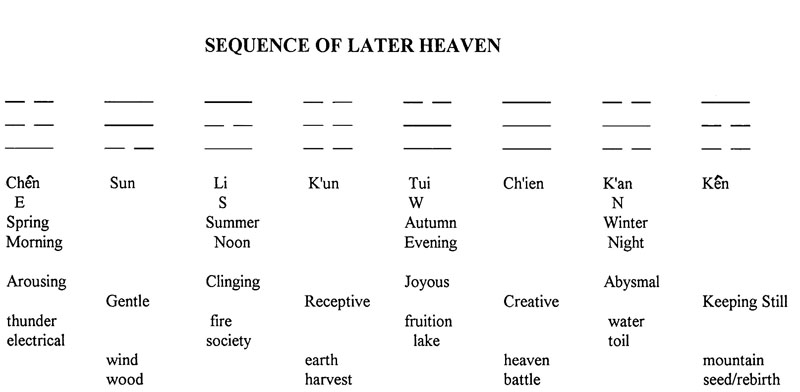Ever since about 1976, I have occasionally used the Chinese Book of Changes, the I Ching, as a source of images with which to focus the composition of various pieces (e.g. Androgyny, Aerial ) Then in 1985 I decided to design a (vinyl) record based on an extended exploration of a configuration of trigrams found within that tradition, known as the 'Sequence of Earlier Heaven', or the Primal Arrangement. In this configuration, the eight basic trigrams are placed in an octagon with each opposite its inverse. On the simplest level, the record can be understood as a cycle of four pieces which correspond to the four elements (air, earth, water, fire), to the cardinal points of the compass (with south at the top), to the seasons and to pairs of symbols -- such as heaven and earth, fire and water, lake and mountain, wind and thunder. Some of the imagery is quite direct -- on Side One, the air and breath of the recorder player in East Wind, and the wood and resonance of the marimba in Nightwatch, and one Side Two, the simulated seascape of Wave Edge and the restless energy suggesting fire in Solar Ellipse. All of these works have since been re-issued on the Cambridge Street Records CDs, Digital Soundscapes, Pacific Rim and Inside.
Within the larger pattern of the four pieces, there are relationships between pieces that may be identified. Just as each side of the record contrasts and complements the other, so too each piece on a side is similarly related to the other. Much of the I Ching imagery plays on the dynamic relation of opposites -- or better, complementary forces -- as symbolized by the broken versus the solid line, the yin and yang. The pattern known as the 'Sequence of Earlier Heaven' places each of the eight basic elements and trigrams opposite each other on a circle. However, instead of portraying such relations as a conflict that must be resolved (as, for example, we find in 19th-century music where 'harmonic tension' inevitably resolves in a cadence), the I Ching plays on a balanced energy that results from the interaction of contrasting forces. In a similar fashion, these pieces play on various sonic and musical contrasts without trying to 'resolve' them.
In 1993 I returned to this source of
inspiration to use the the complementary arrangement of
trigrams in the I Ching known as the Inner-World Arrangement, or 'Sequence
of Later Heaven' through which the primal arrangement shines.
In the later arrangement, the trigrams are shown in a temporal
progression that follows the seasons and times of day,
symbolizing all other temporal patterns of growth and
transformation. This pattern is reflected in the eight
sections of the musical work, Sequence of Later Heaven, which portray the symbolism of each trigram. On
the Song of Songs
CD, the piece is paired with a
cyclic work drawn from the Western tradition (the title track)
and embedded within an even larger cycle of pieces that occupy
the entire disk.

In 1998 I returned to the Sequence of Earlier Heaven which refers to the pattern of trigrams known as
the Primal Arrangement, based on pairs of opposites, such as
Heaven and Earth, Wind and Thunder, Water and Fire, Mountain
and Lake. In the musical work, this progression takes place in
eight sections, where each pair of four channels depicts the
energy generated by these oppositions. Both works are used as
interludes in my electroacoustic opera, Powers of Two.

Reference:
B. Truax, "Sequence of Earlier Heaven: The Record as a Medium for the Electroacoustic Composer," Leonardo, 20(1), 1988, 25-28.